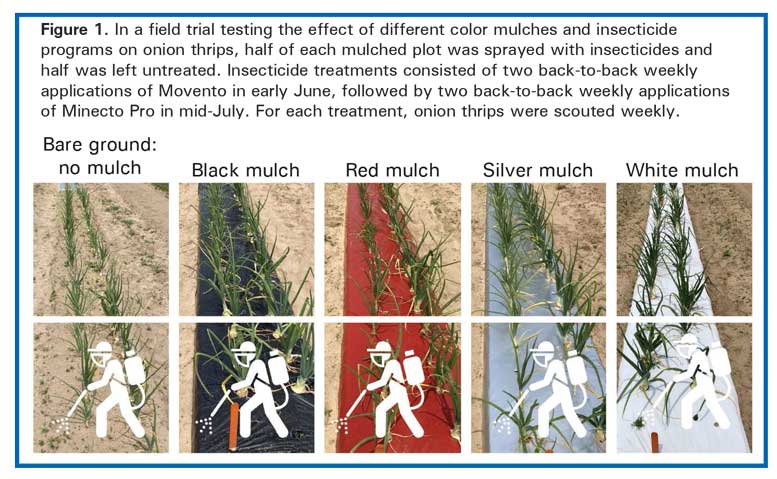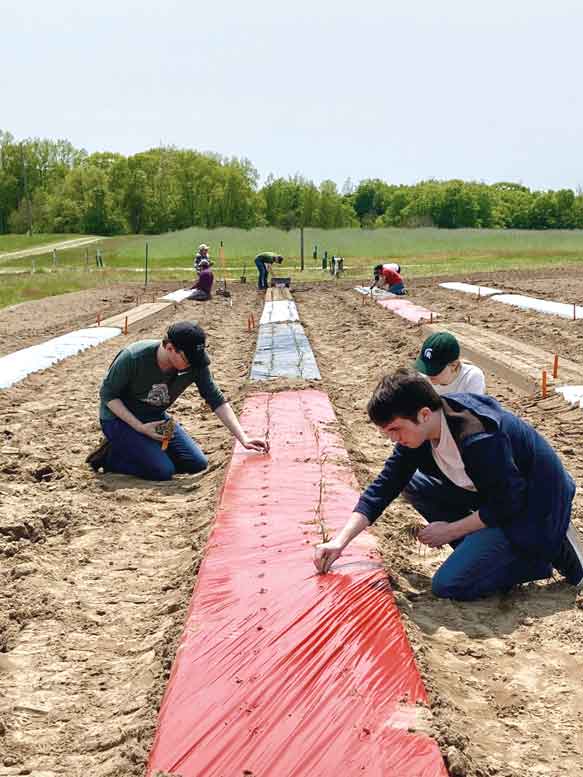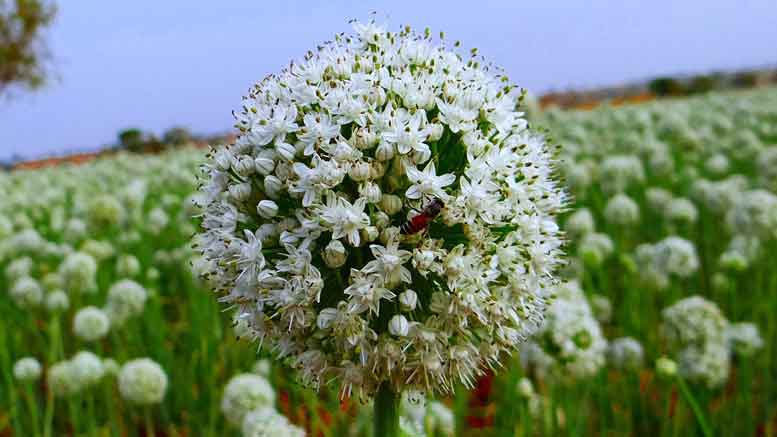|
Click to listen to this article
|
Onion Thrips Control With Plastic Mulches
By Natalie Constancio and Zsofia Szendrei, Department of Entomology, Michigan State University
The use of plastic mulch can be part of an effective strategy for onion thrips management. To help growers maximize the benefits of this tool, researchers at Michigan State University worked to identify best practices for using plastic mulch to control onion thrips.
Onion thrips are a major insect pest of onions. Thrips consume the green leaf tissue of the plant, resulting in a reduced ability to photosynthesize and subsequently a yield reduction for growers. Because thrips can cause significant damage, it is important to have a robust management plan.
Onion thrips are managed with action threshold-based insecticide applications and by rotating the insecticide class to prevent insecticide resistance from developing. While insecticide resistance can be managed, it is important to consider other potential management strategies to further reduce the risk.
Plastic mulches are an alternative strategy for onion thrips management and provide additional benefits to growers. Additional benefits include weed control, increased soil moisture retention and temperature regulation, but selecting the correct color mulch is important. For example, black mulch may help increase soil temperature at the beginning of the season but may become too warm later in the season. White plastic mulches help retain soil moisture but do not increase soil temperature as much as black mulches. However, white plastic and black plastic mulches have been shown to increase thrips populations when compared to bare ground. In contrast, red and reflective silver mulches have been reported to reduce thrips populations.
Interestingly, none of these mulches have been tested in onions, or in combination with pesticides. This led us to ask two questions for onion thrips management: 1) How do plastic mulches and insecticides compare to each other for suppressing thrips? 2) Can we combine these management strategies?

Field Trial
We tested different colored mulches, either with or without a pesticide program applied. The mulch colors and pesticide combinations tested were: 1) bare ground (no mulch) + no insecticide, 2) bare ground + insecticide, 3) black mulch + no insecticide, 4) black mulch + insecticide, 5) red mulch + no insecticide, 6) red mulch + insecticide, 7) silver mulch + no insecticide, 8) silver mulch + insecticide, 9) white mulch + no insecticide, 10) white mulch + insecticide (Fig. 1).
Testing mulch color without a pesticide program allowed us to compare how mulches control thrips populations compared to the standard management practice of bare ground and pesticide treatments. Mulches with pesticide applications allowed us to test whether improved thrips control is achieved with the addition of insecticides. The insecticide program consisted of two back-to-back applications of Movento seven days apart, applied June 6 and 14, followed by two back-to-back applications of Minecto Pro seven days apart on July 11 and 18, and each insecticide application was applied with Syl-Tac 1 percent v-v. Onion thrips were scouted weekly from May 24 through Aug. 18.

Comparing Plastic Mulches, Insecticides
To determine how plastic mulches and insecticides compare to each other, we compared the bare ground + insecticide treatment to the colored mulches without insecticide treatments (Fig. 2). First, we found that white mulches and black mulches were the least effective and increased thrips populations compared to the bare ground + insecticide treatments. On white mulch, there were three times more thrips per leaf (2.2 thrips/leaf) compared to the bare ground + insecticide treatment (0.8 thrips/leaf), and about 60 percent more thrips on the black plastic mulch (1.3 thrips/leaf). On the other hand, the silver reflective mulch and the red mulch without insecticides were as effective as the bare ground + pesticide applications for controlling thrips populations. On the silver reflective mulch, there was a similar number of thrips per leaf (0.7 thrips/leaf) compared to the red mulch (0.7 thrips/leaf).

Combining Plastic Mulches, Insecticides
To understand if insecticides provided additional control when combined with mulches, we compared the bare ground + insecticide treatment to the colored mulches + insecticide treatments (Fig. 3). We first looked at the white mulch + insecticide treatment and found that the addition of an insecticide was not enough to manage thrips, and there was about two and a half times more thrips on the white mulch + insecticide (1.9 thrips/leaf) compared to the bare ground + insecticide treatment (0.8 thrips/leaf). We found that black mulch + insecticide treatment (0.8 thrips/leaf) performed similarly to the bare ground + insecticide treatment (0.8 thrips/leaf). In contrast, silver reflective mulch + insecticide (0.5 thrips/leaf) controlled thrips similarly to the bare ground + insecticide. Red mulch + insecticides were the most effective (0.3 thrips/leaf) at controlling thrips populations and reduced thrips numbers by 60 percent.

Conclusions
Overall, we found that mulches can be as effective for thrips management as insecticides and these two strategies can be combined for improved control. To summarize, white mulches increased thrips populations, and the addition of insecticide applications was not enough to control thrips populations. Black mulch performed similarly to the bare ground treatments. Silver reflective mulch was as effective at controlling thrips as insecticide applications, but silver reflective mulch + insecticide did not provide additional thrips control, indicating that the addition of insecticide was unnecessary. Red mulch controlled thrips populations similarly to the bare ground + insecticide, and the combination of red mulch + insecticide provided the greatest thrips control. These results highlight that plastic mulches can be an alternative solution to insecticides for thrips control, and the effectiveness of insecticides combined with mulches was dependent on the mulch color.

